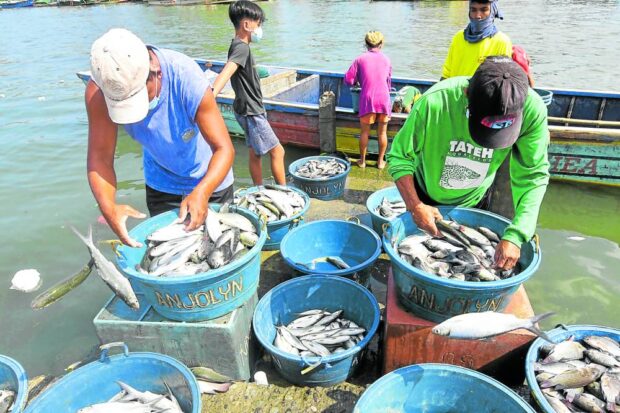Mindanao study finds microplastics in ‘bangus’

Newly harvested bangus from island barangays in Dagupan City are brought to Magsaysay Fish Market. From the boat, they are classified according to size and placed in tubs. (Photo by WILLIE LOMIBAO / Inquirer Northern Luzon)
MANILA, Philippines — A team of researchers has found the prevalence of microplastics (MPs) in the gastrointestinal tracts of adult milkfish (“bangus”), one of the predominant species developed in the country’s aquaculture industry. But because microplastic research in the country is still in its infancy, the full extent of its health risks has yet to be established, according to the team.
Researcher Kaye Similitan of the Mindanao State University-Iligan Institute of Technology (MSU-IIT) said their study found that 97 percent, or 29 out of 30 milkfish samples, were contaminated with MPs.
These samples were taken from fish cages in the portion of the Masao River in Butuan City and in the area of Butuan Bay in Nasipit town, Agusan del Norte province.
The research, funded by the Department of Science and Technology, was conducted last year and published in September in the “Marine Pollution Bulletin” of the Dutch academic publishing company Elsevier.
Earlier scientific studies by the same team of researchers had also detected MPs in Metro Manila’s air and in the waters of Laguna de Bay, the country’s largest freshwater lake.
Article continues after this advertisementBased on the findings of MSU-IIT, an average of 5 MPs was found from milkfish samples in Nasipit while the MP content of milkfish in Butuan City reached an average of 10 MPs, or two times higher.
Article continues after this advertisementIn an interview with the Inquirer, Similitan attributed the MP ingestion in Butuan to economic activity in the city, a leading tourist and investment destination in the Caraga region in northeastern Mindanao.
Team member Hernando Bacosa, an environmental scientist who has been working on microplastics research, explained that the higher amount of MPs in milkfish may be attributed as well to the higher MP concentration in the water since the species tend to mistake waste as food.
“Butuan has high industrial [and] commercial activities and high population, and that is also tantamount to high plastic consumption and disposal that go to canals, esteros, and the sea,” he said. On average, the water in the Masao River has 1 MP per liter, five times higher than that of Butuan Bay in Nasipit which has 0.2 MP per liter.
The Agusan River, another waterway alongside Butuan City, also has so many plastics coming from other parts of Mindanao, Bacosa said.
The Department of Environment and Natural Resources (DENR) also has ongoing research on microplastic levels in different bodies of water around the country.
The DENR’s Ecosystems Research and Development Bureau said there are “no global or local thresholds [yet] on microplastics.”
At any rate, “we don’t have to wait for it (the concentration of microplastics) to reach 100 [MPs per liter] in 10 years or after 20 years,” Bacosa said.
READ: Microplastics: Why we now already breathe, ingest killer plastics
READ: Filipinos losing war against single-use plastics – DENR
READ: Microplastics: Invisible bane to PH fishermen
‘Nanoplastics’
He noted further that MPs could be broken down into smaller compounds called “nanoplastics,” which could penetrate the lungs, liver, and blood.
“If the fish ingests a small amount of MP, it won’t affect the fish. But later on, when the amount increases to as much as 100 MPs in 20 to 30 years, it could affect the fish,” he said.
While the guts are usually removed from milkfish bought in the markets, “we don’t know what percent of the microplastics are nanoplastics that could have entered the meat or the edible part of the bangus,” he added.
Bacosa said microplastics in fish could also be carriers of bacteria, viruses, and harmful chemicals. The team also analyzed the polymer type of MPs and found the most dominant to be ethylene-vinyl acetate (EVA), which Similitan said is mostly used in paint and thinner.
Apart from EVA, other polymers detected were low-density polyethylene (9 percent), the material used for packaging foils; polyethylene terephthalate or PET (8 percent), which comes from PET-made bottles and other containers used for carbonated drinks; the polyvinyl chloride (7 percent) used in pipes; and polyamide (7 percent) used for clothing and fishing gear.
“From that we have an idea: MP is not formed overnight,” Bacosa said. “These MPs could come from 10 or 20 years ago. The MP could be from PET bottles disposed [of] 10 to 20 years ago because it takes time [for these plastics to disintegrate].”
Bacosa said there is no immediate solution to this problem, but certain laws like the Extended Producers Responsibility Act of 2022 (Republic Act No. 11898) can make companies liable for their plastic production.
The law requires, in particular, large enterprises with total assets of more than P1 billion to establish a system to recover, treat, and recycle or dispose of their plastic packaging after the consumption of their products.
“Plastic pollution is not just an issue of the scientists, but we have to work with the national and local governments, businesses that are responsible for the manufacture of plastics, international organizations, and regional alliances,” Bacosa said.
Similitan said local governments like Butuan City could also regulate plastic usage in its tourist spots and implement policies like banning single-use plastics.
Ultimately, proper waste disposal should be observed in households.
“We have to reduce, refuse [the use of plastic], and rethink our current way of life so we can minimize the plastic problem,” Bacosa said.